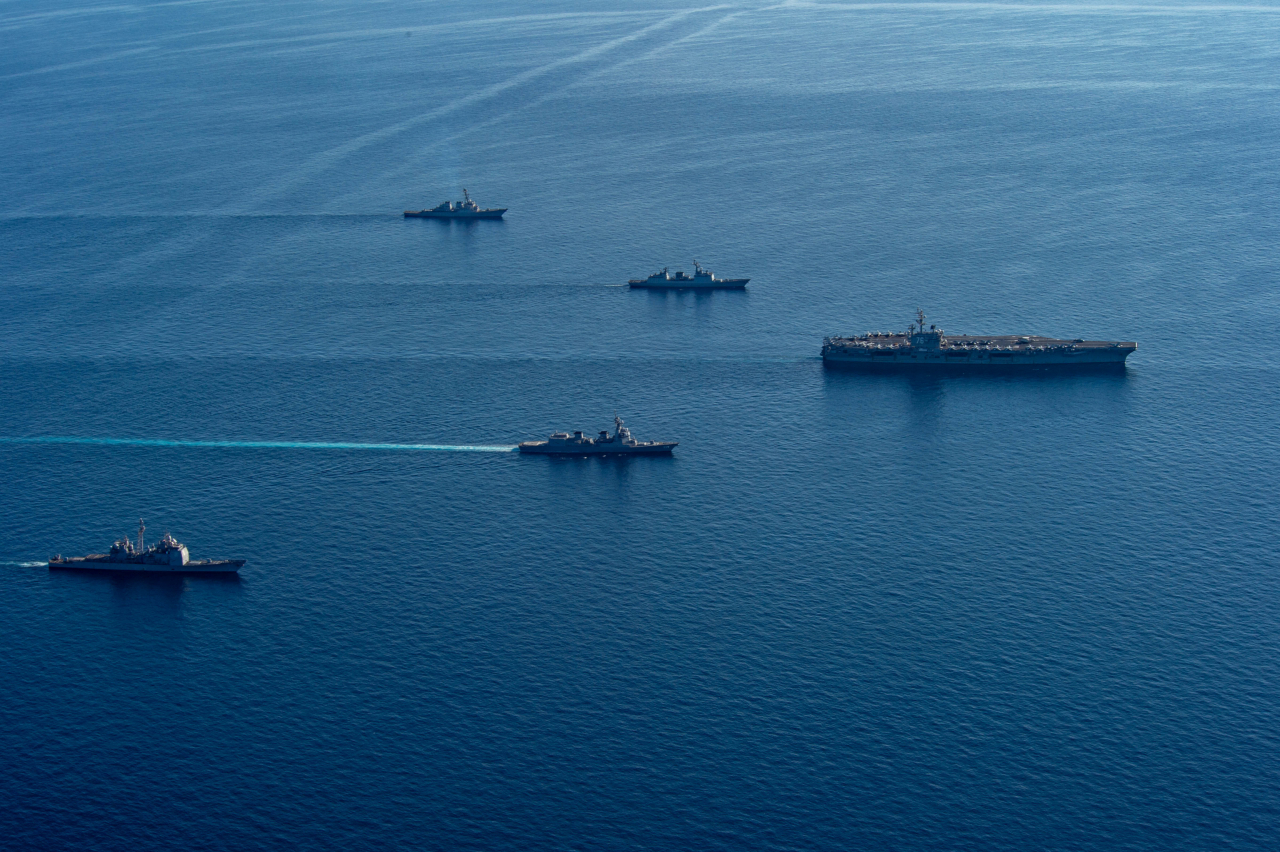S.Korea, US, Japan stage anti-submarine drills amid escalating NK underwater threats
The three countries stage search and rescue exercises for the first time since 2016 to ‘normalize trilateral security cooperation,’ says Seoul
By Ji Da-gyumPublished : April 3, 2023 - 15:48

South Korea, the United States and Japan kicked off their two-day large-scale combined maritime exercises, mobilizing the US nuclear-powered aircraft carrier, the USS Nimitz, and its strike group to enhance combat readiness and interoperability against North Korea’s continued threats, South Korea’s Defense Ministry said Monday.
The South Korean and US navies along with Japan’s Maritime Self-Defense Force started conducting anti-submarine warfare exercises and search and rescue exercises in international waters south of Jeju island on Monday morning.
“The anti-submarine warfare exercises have been designed to enhance the combined response capabilities of South Korea, the US and Japan to North Korea’s underwater threats, including advancements in submarine-launched ballistic missile (SLBM) capabilities,” the Defense Ministry said in a statement.
The drills use expendable mobile anti-submarine warfare training targets, or EMATT, which are capable of simulating the sounds and movements of a submarine, to “enhance the three countries’ capabilities to detect, track, share information and destroy North Korean underwater threats.”
The three naval forces specifically aim to master detecting the sounds of a virtual underwater target, sharing information and striking the target with torpedoes.
“The exercises that utilize EMATT, which is only a few meters in size, are significant in demonstrating the Navy’s ability to counter North Korea’s moves in developing the capabilities of Unmanned Underwater Vehicles, including the underwater attack drone named ‘Haeil’ that North Korea recently disclosed through its state media,” a South Korean military official said on condition of anonymity.
The trilateral anti-submarine warfare drills were staged for the first time in six months, marking the first such drills since September last year, as North Korea ratcheted up its underwater threats by disclosing newly developed weapons this month.
North Korea claimed it tested a nuclear-capable underwater attack drone -- which was developed to submerge stealthily into enemy operational areas and destroy enemy warships and key naval bases by generating a radioactive tsunami -- twice in March.
North Korea fired two submarine-launched cruise missiles, or SLCMs, for the first time in mid-March.
“The exercises serve as a great opportunity to enhance the capabilities of South Korea, the US and Japan to carry out maritime operations to counter underwater threats posed by North Korea,” Rear Adm. Kim In-ho, commander of South Korean Navy’s Maritime Task Flotilla Seven, or MTF 7, said.
“We will neutralize any kind of North Korean provocation by responding overwhelmingly and decisively.”
The US Navy’s 100,000-ton nuclear-powered aircraft carrier, the USS Nimitz (CVN-68), and her strike group consisting of the Arleigh Burke-class guided-missile destroyers, the USS Wayne E. Meyer and USS Decatur, have been mobilized for the trilateral naval drills.
These trilateral drills are coming shortly after the US strike carrier group left a naval base in the southeastern port city of Busan after staying for almost a week from March 28 to April 2 to show the US’ unwavering commitment to the defense of South Korea.
The South Korean Navy has dispatched destroyer Yulgok YiYi, equipped with the Aegis Combat System, and its key destroyers, the Choi Young and Dae Jo Yeong, as well as the fast combat support ship, the Soyang. Japan Maritime Self-Defense Force’s Asagiri-class destroyer, the Umigiri, has participated in the trilateral naval drills.
The three countries also have staged search and rescue exercises, known as SAREXs, for the first time since 2016 as part of their efforts to “normalize trilateral security cooperation,” South Korea’s Defense Ministry said.
During the training, the naval forces of the three countries aim to master conducting maritime search and rescue operations, providing emergency medical treatment and transporting patients in the event of maritime accidents.
The trilateral SAREXs, which are designed to enhance their interoperability to respond to disasters and provide humanitarian assistance, were initially staged in 2008.
Seoul, Washington and Tokyo had conducted SAREXs once or twice a year until 2016. But nonmilitary trilateral exercises, including a maritime interdiction exercise as well as SAREXs, had been suspended especially in the aftermath of a radar lock-on dispute between South Korea and Japan in 2018.
In January, South Korean Defense Minister Lee Jong-sup unveiled the ministry’s plan to regularize trilateral anti-submarine warfare exercises, missile warning and ballistic missile search and tracking exercises, as well as to resume nonmilitary trilateral exercises in a bid to step up trilateral security cooperation.



![[Herald Interview] 'Amid aging population, Korea to invite more young professionals from overseas'](http://res.heraldm.com/phpwas/restmb_idxmake.php?idx=644&simg=/content/image/2024/04/24/20240424050844_0.jpg&u=20240424200058)













![[KH Explains] Korean shipbuilding stocks rally: Real growth or bubble?](http://res.heraldm.com/phpwas/restmb_idxmake.php?idx=652&simg=/content/image/2024/04/25/20240425050656_0.jpg&u=)

